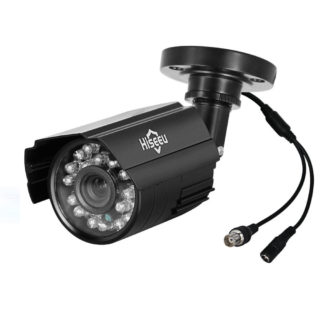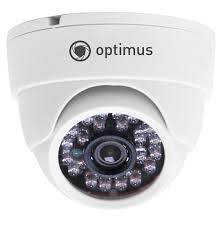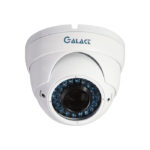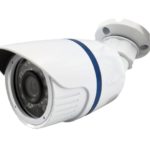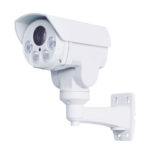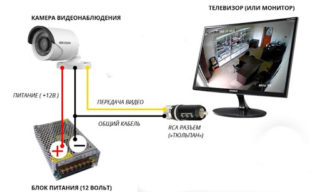Surveillance cameras are selected according to various parameters, including the type of transmitted signal. Digital models today are considered more convenient and efficient, but analog options are still in demand. AHD camera is one such solution.
AHD Camera Definition
AHD technology enables the transfer of very high resolution analog images atypical of a conventional model. This is the result of the development of the usual television standard - 25 frames per second. In contrast, AHDs use progressive scan. When recording and digitizing, an image is obtained up to 1080 p. Moreover, signal transmission via coaxial cable is possible at a distance of up to 500 m.
The camera is based on high-tech CMOS sensors. Usually they create a higher noise level, but on modern AHD-cameras this disadvantage is eliminated. The signal from the matrix in digital format is transmitted to the processor, where the luminance and color component of the image is processed separately according to its own algorithm. In this case, a noise reduction system is used. As a result, the consumer gets a clear high-quality image without extraneous noise.
From the processor, the digital signal goes to the converter - DAC, where it is transformed into analog. Lossless data is transmitted via coaxial cable to a distance of up to 500 m.
Another plus is the ability of Ahd Camera to create equally clear and detailed images both day and night. Analog devices have an ICR filter. This is an infrared filter that separates thermal radiation during the day, affecting contrast and clarity. At night, the filter does not work and, thanks to IR illumination, provides a high-quality picture in the absence of lighting.
The main difference between the device is the lack of compression.
Subspecies and Characteristics
Devices are available for internal installation and for external. In the latter case, the cameras have a more robust housing and protection against moisture, dust and cold. Since AHD camcorders are constantly compared with digital ones for the user, the main criterion is the resolution and signal quality. According to this parameter, devices are divided into 3 categories.
Ahd-l
This is an unofficial version of the AHD 0.8 standard. Resolution does not exceed 960 * 576, which does not meet the requirements of HD technology. The camera has a different color coding option. This improves the clarity of the image eliminates the "ladder". However, when connected to the old D1, the picture is black and white.
Ahd-m
AHD 1.0 standard with a resolution of up to 1280 * 720 pixels. The image is similar to a 1 megapixel camera. For data transmission use only a coaxial cable.
Ahd-h
AHD 2.0 standard. resolution reached 1920 * 1080 p. The standard supports 2 megapixel cameras, other devices with a resolution of 720 to 1080 r and provides viewing the video stream of the same level. Speed - 30 frames per second.
All device options can be connected to the DVR.
Criterias of choice
An AHD camera is much less expensive than an IP camera. If there are no ultra-high image requirements, this option is preferable. Which standard is better - AHD 1.0 or AHD 2.0 is again determined by the desire to see a picture with one degree or another of clarity.
The second determining factor is the purpose of the video device:
- Miniature - do not catch the eye, are used for video surveillance in an apartment or private house.
- Dome - a modular version, it is built into the ceiling. The camera is closed by a tinted hemisphere and its direction cannot be traced.
- Housing - often equipped with telephoto and wide-angle lenses. Designed for installation in industrial premises and shopping centers.
- Outdoor AHD video surveillance is collected from PTZ cameras. Telecontrol signals are transmitted along the same coaxial wire through which a video signal passes to the recorder, so that extra wires are not needed.
- Dome
- Cabinet
- PTZ Outdoor PTZ Camera
The next important parameter is the focal length. It is inversely related to the viewing angle, so when choosing it is worth determining which moment is more important:
- with 2.5 mm RF, the viewing angle is 120 degrees, but the distance of reliable identification reaches only 2 m;
- with 4 mm RF, the angle decreases to 65 degrees, and the distance grows to 4 m;
- with a 12 mm FR, the angle is only 25 degrees, and the distance increases to 12 m.
If high detail is not needed, it is worth taking a camera with a low FR, since here the viewing angle will be more important.
The sensitivity of the camcorder is selected by the level of lighting. If the device works round the clock, the sensitivity should be at least 0.01 lux.
Noise level is important if cameras are placed in a home or office. In a good model, the noise level does not exceed 45–48 dB.
An AED camera with a low noise level of 50 dB and a high resolution costs almost 2 times more than a model with 45 dB.
Differences from IP cameras
Which is better - AHD or IP video surveillance, depends on the purpose and device of the system. Characteristics are presented in the table.
| Parameter | IP | Ahd |
| Signal | Digital | Analogue |
| Signal delay | Not more than 1 s. In case of unsuccessful connection scheme up to 20 s | No |
| Transmission distance | 100 m. When using an optical cable 20 km | 500 m |
| Cable type | Twisted pair optical | Coaxial |
| Power transfer | there is | No |
| Cost | More expensive | Cheaper |
| Optional equipment | Router or switch | DVR only |
 IP or AHD based surveillance is comparable in performance. Both devices give a picture of almost equal resolution. When choosing, proceed from other parameters:
IP or AHD based surveillance is comparable in performance. Both devices give a picture of almost equal resolution. When choosing, proceed from other parameters:
- distance - when transmitting no more than 100 m, an IP camera is preferable. If the distance is about 400 m, the AD is better;
- if you combine many cameras into the system, it is better to take digital ones;
- if the structure is being upgraded, and coaxial cables are already there, it is cheaper to buy analog ones;
- if hang is unacceptable, video output to AHD is better.
It is allowed to install a hybrid system, since a modern DVR can work with cameras of any kind.
Advantages and disadvantages
The advantages of an analog device are palpable:
- ease of connection - devices do not need to be set up;
- the signal is stable, freezes are excluded;
- ease of integration into an existing structure and the ability to work in parallel with digital devices;
- low cost compared to IP models.
Among the disadvantages is the possibility of interference caused by electromagnetic radiation. The camera is not a standalone device. Recording is possible only on the DVR.
Connection Features
A typical video surveillance scheme when connecting AHD cameras includes the following elements:
- cameras - placement points are determined in advance;
- a DVR with a hard disk of at least 1 TB, since analog recording weighs a lot;
- coaxial cables and wires;
- modular spark gap - shuts down the system during power surges;
- modular connectors and terminals.
The main difference between installing an analog system compared to digital is that in addition to purely physical work on installing fixtures and connecting cables, you do not need to do anything. The cameras start working immediately after they are connected to the network.
Manufacturers Overview
The most famous company in the Russian market is the company Dahua. It offers models for indoor and outdoor installation and with different resolutions. Mounting possible with integrated microphone.
Division - manufacturer of analog devices of any type.Most devices support several standards besides AHD. Due to the successful combination of quality and cost, the models are very in demand.
Neostar - A well-known developer of video surveillance systems. It offers digital and analogue recording devices, as well as recorders, video intercoms and other elements. A distinctive feature of cameras is the ability to improve the received image.
Partizan - The English manufacturer offers video recorders and video cameras, including robotic ones.
